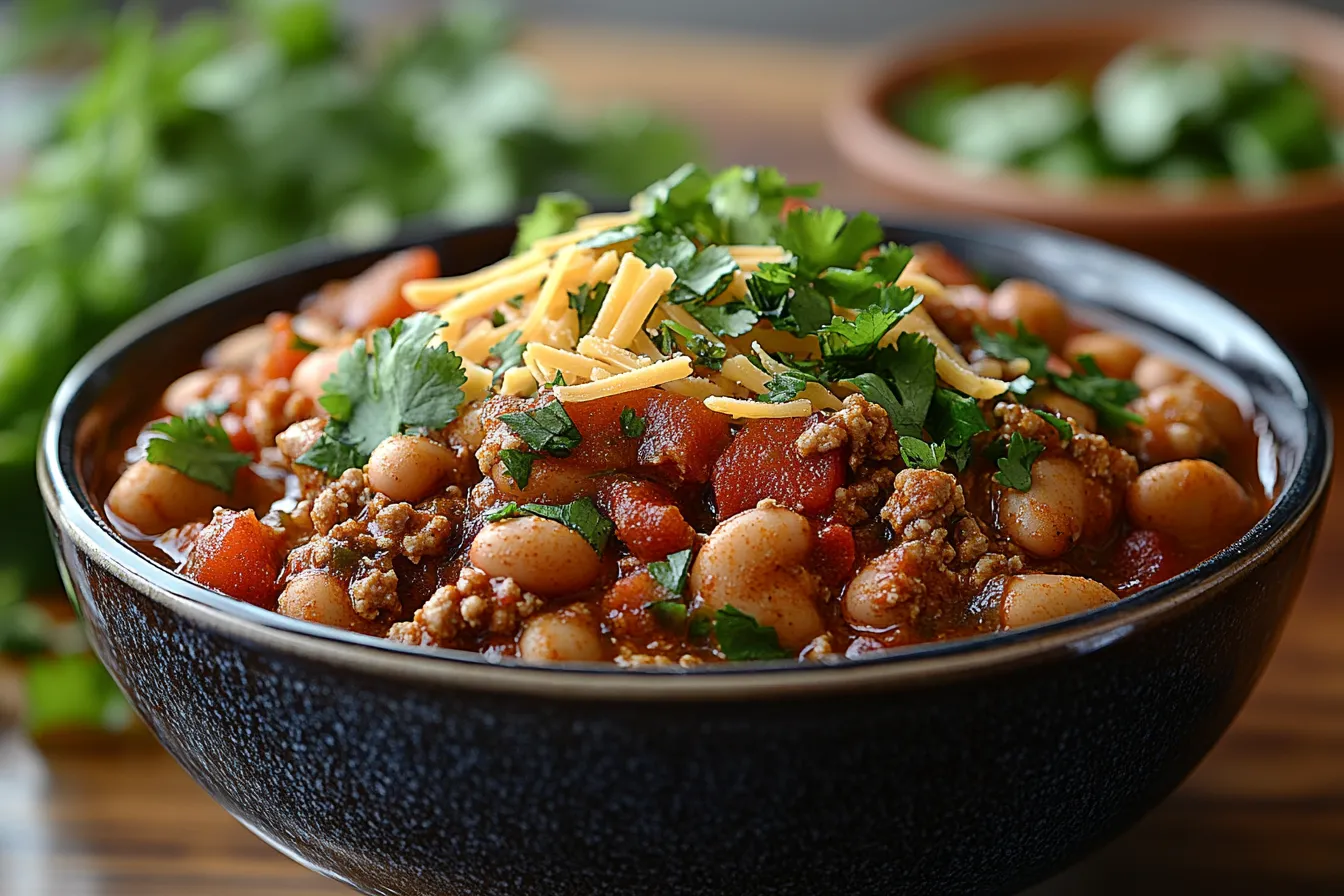Discover how to make the ultimate turkey chili with this detailed guide, offering rich flavors and a healthy twist on a classic favorite.
Turkey chili is a wholesome and flavorful dish that has become a staple in many American homes. Packed with lean protein, beans, and vibrant spices, it offers a lighter yet equally satisfying alternative to traditional beef chili. Furthermore, this guide explores the history, preparation, variations, and tips to master this beloved recipe. It is not only a delicious choice but also a nutritious one that can fit seamlessly into various meal plans. Let’s dive into the world of turkey chili and learn how to make it perfect every time.
The History of Turkey Chili
Chili, a dish with deep roots in American and Mexican cuisine, traditionally features meat, chili peppers, and a variety of spices. Its origins trace back to the 19th century when cowboys and pioneers needed hearty meals that could be prepared over an open flame. Over time, chili evolved into many regional variations, with turkey chili emerging as a health-conscious alternative.
The rise of turkey chili aligns with the increasing focus on healthy eating in the late 20th century. Lean ground turkey, a substitute for beef, became popular due to its lower fat content. Moreover, turkey chili gained attention for being adaptable, allowing home cooks to infuse their own twist with regional flavors or dietary-specific adjustments. Today, turkey chili is celebrated not only for its nutritional benefits but also for its versatility, adapting to various dietary preferences and flavor profiles. This evolution has solidified its position as a modern-day favorite in kitchens across America.
Why Choose Turkey Chili?
Turkey chili is more than just a healthier option; it’s a dish that combines robust flavors with nutritional value. Here are some reasons why turkey chili is a favorite:
- Health Benefits: Turkey is a lean protein, low in saturated fat and high in essential nutrients like zinc and selenium. Compared to beef, turkey provides a lighter alternative without compromising on taste.
- Rich Flavor: Despite being lighter than beef, turkey pairs wonderfully with bold spices and other chili ingredients, delivering a satisfying taste. The addition of beans, vegetables, and a variety of seasonings ensures a rich and hearty profile.
- Versatility: Turkey chili can be customized to suit spicy, mild, or unique flavor preferences, making it suitable for every palate. Additionally, it can be adjusted for dietary needs such as gluten-free or low-carb.
- Ease of Preparation: With simple ingredients and straightforward steps, it’s a go-to recipe for busy weeknights or meal prep. Its ability to be cooked in a slow cooker or pressure cooker adds even more convenience for modern households.
Essential Ingredients for Turkey Chili
Core Components
- Ground Turkey: Opt for lean or extra-lean ground turkey for a healthy base. Turkey absorbs flavors well, making it ideal for chili.
- Beans: Kidney, black, or pinto beans provide texture and fiber, enhancing the heartiness of the dish.
- Tomatoes: Canned diced tomatoes or tomato sauce build a rich and tangy base. Fresh tomatoes can be used for a garden-fresh flavor.
- Onion and Garlic: Aromatics that add depth to the dish. Sautéing these ingredients ensures they release their natural sweetness.
- Spices: Chili powder, cumin, paprika, and oregano create the signature chili flavor. Adding smoked paprika can give an extra dimension to the flavor.
- Broth: Chicken or vegetable broth ensures the chili remains moist and flavorful. The liquid also helps meld the ingredients together during simmering.
Alternative Ingredients
- Vegetables: Bell peppers, zucchini, or corn for added nutrition and color. These vegetables contribute texture and make the chili more vibrant.
- Substitutions: Use ground chicken or plant-based turkey for variations. These alternatives cater to dietary needs and preferences.
- Enhancers: Add a pinch of cinnamon or cocoa powder for depth. These ingredients can balance out the heat and acidity, providing a unique twist to the traditional flavor profile.
Equipment Needed
- Dutch Oven or Large Pot: Ideal for even cooking and holding all ingredients. This type of pot retains heat well and ensures thorough cooking.
- Cutting Board and Knife: For prepping vegetables and herbs. Sharp tools make the preparation quicker and safer.
- Measuring Spoons and Cups: Ensure precise seasoning and consistency. Proper measurements are crucial for balancing flavors.
- Wooden Spoon: Perfect for stirring without scratching cookware. It is also great for breaking up the ground turkey during cooking.
Having the right tools simplifies the cooking process and ensures a seamless experience from start to finish. Additionally, the proper equipment enhances flavor consistency and overall texture, making the final dish more appealing.
Step-by-Step Guide to Making Turkey Chili
1. Preparation
- Chop onions, garlic, and any additional vegetables you plan to include. Fresh vegetables enhance the overall flavor and texture.
- Measure out spices, beans, and liquids for efficiency. Pre-measuring ingredients can save time and reduce stress during cooking.
- Ensure all ingredients are within reach before starting. A well-organized workspace ensures smoother execution of the recipe.
2. Cooking the Turkey
- Heat a tablespoon of oil in your pot. Olive oil or avocado oil works well for this step.
- Add ground turkey and cook until browned, breaking it into small pieces as it cooks. Browning adds flavor and helps seal in moisture.
- Remove turkey and set aside, retaining any rendered juices for added flavor. This step ensures the turkey doesn’t overcook while the base is being prepared.
3. Building the Flavor
- Sauté onions and garlic until translucent. Stirring frequently prevents burning and ensures even cooking.
- Stir in spices and toast briefly to release their aroma. Toasting spices enhances their natural oils, creating a richer base.
- Return turkey to the pot and mix thoroughly. Ensuring even mixing at this stage is key to a cohesive flavor profile.
4. Simmering the Chili
- Add tomatoes, beans, and broth to the pot. Mixing well ensures all ingredients are evenly distributed.
- Bring to a gentle boil, then reduce to a simmer. This gradual temperature adjustment helps meld the flavors together.
- Let the chili cook for 30-40 minutes, stirring occasionally, to develop rich flavors. Additionally, longer simmering deepens the taste and enhances the texture, creating a more satisfying dish.
5. Final Touches
- Taste and adjust seasoning with salt, pepper, or additional spices. Adjustments at this stage allow for personalization.
- Garnish with fresh cilantro, green onions, or a dollop of sour cream. Toppings not only add flavor but also enhance the visual appeal of the dish.
Nutritional Information
Turkey chili is a nutrient-dense dish that supports a balanced diet. A typical serving contains:
- Calories: Around 300-400, depending on ingredients. Adjusting toppings can influence calorie content.
- Protein: Approximately 25-30 grams per serving. This makes it a great option for muscle recovery and overall health.
- Fiber: High fiber content from beans promotes digestive health. Fiber also contributes to satiety, keeping you full longer.
- Low Saturated Fat: Compared to beef chili, turkey chili is heart-healthy. Its lower fat content makes it ideal for those watching cholesterol levels.
For lower sodium, use reduced-sodium broth and canned goods. To increase vegetables, add more zucchini or spinach. Furthermore, making your own broth ensures a healthier, fresher option that enhances the dish’s flavor.
Turkey Chili Variations
1. Spicy Turkey Chili
- Add jalapeños, cayenne pepper, or hot sauce for heat. Additionally, a dash of smoked paprika can elevate the smoky flavor. Spicy turkey chili is perfect for those who enjoy bold and fiery flavors.
2. White Turkey Chili
- Use white beans, green chilies, and a creamy broth base for a lighter, tangier version. This variation is a refreshing change from traditional red chili.
3. Vegetarian Turkey Chili
- Replace turkey with plant-based meat or extra beans for a vegetarian twist. This option is excellent for accommodating dietary preferences without sacrificing flavor.
4. Sweet Turkey Chili
- Incorporate sweet potatoes or a touch of maple syrup for subtle sweetness. This variation balances heat and sweetness effectively, creating a unique flavor profile.
Serving Suggestions
- Sides: Serve with cornbread, tortilla chips, or rice. Moreover, warm crusty bread is an excellent accompaniment that soaks up the rich broth.
- Toppings: Try shredded cheese, avocado slices, or pickled jalapeños for added flavor. Toppings provide a layer of customization, making each bowl unique.
- Beverages: Pair with iced tea, light beer, or sparkling water. These drinks complement the robust flavors of turkey chili.
Storing and Reheating Turkey Chili
Proper Storage
- Refrigerate in an airtight container for up to 4 days. Proper storage preserves flavor and texture.
- Freeze in portions for up to 3 months for easy meal prep. Freezing in single servings makes reheating convenient.
Reheating Tips
- Warm on the stovetop over low heat, stirring frequently. For a quicker option, use the microwave, stirring halfway through.
- Adding a splash of broth or water can refresh the consistency. This step ensures the chili remains just as hearty and delicious as when freshly made.
Common Mistakes and How to Avoid Them
- Overcooking Turkey: Leads to dry meat that lacks flavor. To prevent this, cook the turkey just until it is no longer pink before adding other ingredients. Also, keep the heat moderate during the cooking process.
- Underseasoning: A bland turkey chili can ruin the experience. Taste and adjust the seasoning multiple times throughout the cooking process to ensure a balanced flavor.
- Skipping Simmering: Simmering allows the flavors to meld together, creating a more cohesive and delicious chili. Always allocate enough time for this step, as it is key to depth of flavor.
- Using Too Much Liquid: Excess liquid can dilute the flavors and make the chili soupy. Start with less broth and add more gradually if needed.
- Burning Aromatics: Onions, garlic, and spices can burn quickly if cooked on high heat. Stir constantly and reduce the heat as needed to avoid this common mistake.
By avoiding these pitfalls, your turkey chili will consistently turn out rich, flavorful, and satisfying.
Tips for Perfect Turkey Chili
- Use Fresh Ingredients: Fresh vegetables, spices, and herbs make a significant difference in the flavor and aroma of the dish.
- Layer Flavors: Add spices in stages, starting with the base ingredients and adjusting during simmering. This ensures a more complex and balanced flavor.
- Experiment with Spices: Don’t hesitate to add a dash of unexpected spices like cinnamon, nutmeg, or even a splash of apple cider vinegar to elevate the chili’s depth.
- Cook Low and Slow: Simmering the chili on low heat for an extended period enhances the flavor and creates a thick, hearty texture.
- Customize the Heat: Adjust the level of spiciness by varying the amount of chili powder, jalapeños, or cayenne pepper to suit your taste.
- Toppings Matter: Add a dollop of sour cream, grated cheese, or freshly chopped herbs to take the dish to the next level. These elements provide additional texture and flavor.
- Plan Ahead: Turkey chili often tastes better the next day after the flavors have had more time to meld together. Make a larger batch and enjoy leftovers.
By following these tips, you’ll achieve a turkey chili that’s both flavorful and tailored to your preferences every time.
Conclusion
Turkey chili is a versatile, nutritious, and flavorful dish perfect for any occasion. Whether you prefer it spicy, creamy, or sweet, this recipe adapts effortlessly to your preferences. Additionally, its ease of preparation makes it an excellent choice for busy households. From hearty weekday dinners to crowd-pleasing party meals, turkey chili offers something for everyone. Start your turkey chili journey today and savor the warmth and comfort it brings to your table. Don’t forget to share your creations and inspire others with your personal twist on this classic dish.
For more Lunch recipes, check out our Lunch Recipes for more ideas.

